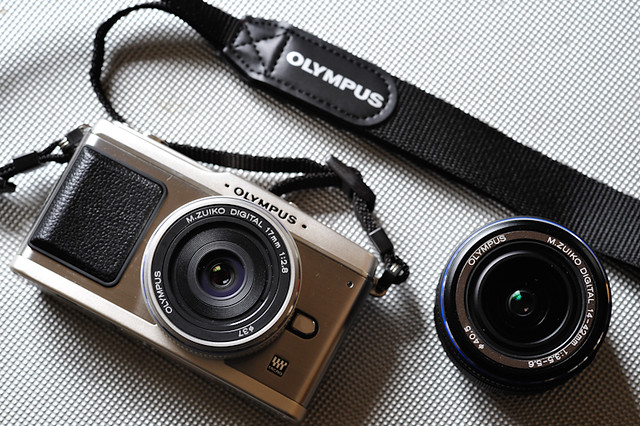If you like this post, help us share it
Ever since the introduction of E-P1 and GF1 by Olympus and Panasonic three years ago, the market for micro four thirds (m4/3) cameras has been growing. The m4/3 camera combines a four third image senor which is 9 times larger than the camera sensor in P&S cameras, in a compact body by removing the need of mirror box and pentaprism. Sony has also followed a similar footstep by introducing their NEX series cameras. The NEXs have an even smaller body but equipped with a 30-40% larger APS-C sensor than the m4/3. Fujifim recently released their X100 which brought back the design of classic cameras and analogue controls. Nikon and Canon have yet to release their equivalent, but we could be hearing some announcements very soon.
All these cameras are very much smaller than any entry level of DSLRs, which make them very popular for travel and casual shoot. Even with two lenses, this is still a relatively light travel gear compare to the DSLR equivalent.
Olympus E-P1 with 17mm f/2.8 and 14-42mm f/3.5-5.6

Their advantages apart from having a smaller and lighter body, the lenses are also much smaller and less expensive, even with f/2 and f/2.8 fast lenses. They are capable of producing some very good HD videos too. However the draw backs are also due to the compactness of the design where smaller sensor size in comparison to those in DSLRs means ISO performance and DoF are compromised. There are also fewer dedicated switches so most configuration is done through the in-menu setting.
I have used the Olympus E-P1 since about one year ago. A year later, I still like shooting with the E-P1 as a light weight camera. Since then there have been the release of E-P2 and E-P3. The E-P2 only had some subtle changes over the E-P1, most significantly adding the hotshoe function. The E-P3 had some significant upgrades, adding a built in flash which I don’t think is all that necessary. The camera’s processors and shutter mechanism have also been improved which allows a much faster autofocus and much snappier overall response.
The m4/3 and other mirrorless interchangeable lens cameras are becoming the mainstream. Their functionality and performance are closely matched to those of entry level DSLRs.
You have probably read a lot of reviews on the m4/3 cameras already, the technology is not exactly new, so I don’t need to repeat it here. I will however put up some image samples taken with the E-P1 on my recent venture. It was a much more relax day just shooting with the E-P1, less equipment means more time for everything else. Changing lenses were very simple, I can even fit the 14-42mm lens in my jacket pocket.
For the session, I only used the 17mm f/2.8 and 14-42mm f/3.5-5.6 lenses. The images were taken indoor so I mostly shot at ISO 800 which is the highest I would like to use normally on m4/3.
Let’s meet Richard, the owner of Heaven Woodfire Pizza at upper Cuba Street, Wellington. They make heavenly woodfire pizzas and flatbreads there. He was a very nice chap to talk to and he generously showed me how their famous woodfire pizza and flatbread were made in the custom build wood fire oven. I took some shots of the place using the E-P1 in this session.
The pizzas prepared from the finest fresh ingredients – Lebanese herbs, pancetta, basil, mozzarella. On the menu you can choose from over 18 types of woodfire pizzas, as well as salads, platters, woodfired flatbread and heavenly delights.


I got closer to the woodfire oven and watched how the woodfired flatbreads were made. The exposure metering was spot on even with such high contrast images. There were some shutter lag, but had no major problem shooting images in succession.


Making of woodfired flatbread.





The woodfired flatbread & Dips (left) and Baklava (right)


Macchiato – Cuba street is famous for its coffee

We chose the “designer” woodfire pizza which filled with our selection of toppings – smoked chicken, smoked salmon, prawns and calamari. I look forward to trying the Pancetta on my next visit.

One advantage of using the E-P1, m4/3 or mirrorless is that you can actually shoot quite close to your subject which is perfect for those macro shots, like food details. If done correctly, you can still shoot with a shallow DoF, but of cause nothing like what the Nikon 24mm f/1.4 can do.



From these image samples, I can say shooting at ISO800 is very acceptable on m4/3 and mirrorless cameras. It can get a bit noisy when you are using ISO1600. However, since the camera is much lighter, you can probably handheld a slower shutter speed than with a DSLR. With ISO limited to 800, I find the 17mm f/2.8 is much more helpful with the extra bit of light. The 17mm (34mm FF equivalent) is also perfect for these kinds of shots.
Remember to visit Richard at Heaven Woodfire Pizza for their great woodfire pizzas and flatbread.




Where can I find the equipment seen on this site?
If you find this site useful and planning to purchase any of the equipment seen on this site, please show your support by purchasing your photo equipment at B&H Photo Video, or through any of the affiliate links seen on this site.

